
| A2 ▏1.2363/X100CrMoV5 ▏SKD 12 ▏Cr15Mo1V | |
Category | Cold work tool steel | |
Delivery condition | Hot rolled & Hot forged, annealed to max. 240HB | |
Supply form | Round bar, Flat bar | |
A2 steel is one of the most readily available and widely used tool steel grades. It has deep hardening, low distortion and high heat treatment safety, high resistance to high temperature softening and medium resistance to decarburization. It has a tendency to retain austenite. During tempering and double tempering, austenite is usually eliminated or reduced to a insignificant amount. A2 Cold work tool steel equivalent material includes European EN, ISO, German DIN EN ISO 1.2363/X100CrMoV5, Japanese JIS standard SKD12, Chinese GB Cr15Mo1V, etc. |
Equivalent Material & Chemical Composition
Standard | Grade | C | Si | Mn | P≤ | S≤ | Cr | Mo | V |
GB | Cr5Mo1V | 0.95-1.05 | ≤0.50 | ≤1.0 | 0.03 | 0.03 | 4.75-5.50 | 0.90-1.40 | 0.15-0.50 |
AISI | A2 | 0.95-1.05 | 0.10-0.50 | 0.40-1.00 | 0.03 | 0.03 | 4.75-5.50 | 0.90-1.40 | 0.15-0.50 |
DIN | 1.2363/X100CrMoV5 | 0.95-1.05 | 0.10-0.40 | 0.40-0.80 | 4.80-5.50 | 0.90-1.20 | 0.15-0.35 | ||
JIS | SKD12 | 0.95-1.05 | 0.10-0.40 | 0.40-0.80 | 0.03 | 0.03 | 4.80-5.50 | 0.90-1.20 | 0.15-0.35 |
Characteristics
« MC 1.2363 is air cooled medium chromium cold working tool steel with high toughness and hardness.
« The smelting process of EAF+LF+VD or EAF+LF+VD+ESR is adopted to meet the requirements of metal stamping die and high-strength precision injection mould respectively.
« UT as per SEP 1921-84 D/d level, ESR material E/e level.
« High toughness and anti-collapse Angle twice that of SKD11.
« High wear resistance and cutting performance is better than SKD11.
« Low dimensional changes of heat treatment.
Mould plates and inserts as well as cutting punches, wear plates and cutting plates with high requirements on toughness. Cutting and punching tools, Rollers, Shear blades, Thread rolling dies, Cold stamping tools, Calibration and pilgrim mandrels, Moulds for plastics processing, Gauges and measuring tools.
Physical Properties
Properties | Metric |
Density | 7.86×10³kg/m³ |
Elastic modulus | 190 - 210 GPa |
Poisson's ratio | 0.27 - 0.30 |
Coefficient of thermal expansion | 10.7-12.7 μm/m-°C |
Mechanical Properties
Properties | Metric |
Toughness | It has outstanding toughness and can withstand significant mechanical stress without cracking or breaking. It can still maintain relatively good toughness even at high hardness levels. |
Compressive Strength | It is relatively high and can endure large amounts of pressure. |
Hardness | 63-65 HRC |
Wear Resistance | It is good. In cold work die applications, it can resist wear and maintain the precision and service life of the dies. |
Heat Treatment
Annealing
Heating Temperature: It is usually between 845 °C and 870 °C.
Soaking Time: It varies from 1 hour for light steel to 4 hours for heavy steel and high-alloy steel.
Cooling Rate: Cool down to 705 °C at a rate of no more than 22 °C/H, and the Brinell hardness is between 201 and 229 Hb.
Quenching
Preheating: Generally, preheating is carried out at around 788 °C.
Austenitizing Temperature: It is between 925 °C and 980 °C. Different austenitizing temperatures will have an impact on the hardness after quenching. Usually, it can be selected between 1700 °F and 1800 °F.
Soaking Time: The minimum austenitizing holding time is 20 - 45 minutes. For case hardening, keep for 30 minutes per inch of the package cross-section.
Quenching Medium: Air or nitrogen cooling can be chosen, and the quenching hardness is generally between 62 and 65 Hrc.
Tempering
Temperature Range: The tempering temperature is usually between 175 °C and 540 °C. Common tempering temperatures include 200 °C, 300 °C, 400 °C, 500 °C, 600 °C, etc.
Soaking Time: Maintain the temperature for at least one hour for every inch of the total thickness.
Number of Tempering Times: Generally, one tempering is sufficient, but for some cases with higher requirements, multiple tempering may be needed.
In actual production, appropriate adjustments and optimizations of the heat treatment process also need to be made according to specific factors such as the shape, size, performance requirements of the dies and equipment conditions.
| O1 ▏1.2510/95MnWCr5 ▏SKS3 ▏9CrWMn ▏9ХBГ | |
Category | Cold work tool steel | |
Delivery condition | Hot rolled & Hot forged, Soft annealed to max. 229HB | |
Supply form | Round bar, Flat bar | |
AISI O1 steel belongs to oil-quenched cold work die steel. It is a widely used tool steel and occupies an important position in the field of industrial manufacturing. It is especially suitable for making various molds and tools that have relatively high requirements for dimensional accuracy and deformation control. O1 Cold work tool steel equivalent material includes European EN, ISO, German DIN EN ISO 1.2510/95MnWCr5, Japanese JIS standard SKS3, Chinese GB 9CrWMn, etc. | 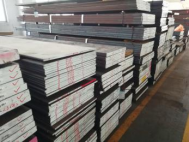 |  |
Equivalent Material & Chemical Composition
Standard | Grade | C | Si | Mn | P≤ | S≤ | Cr | V | W |
GB | 9CrWMn | 0.85-0.95 | ≤0.40 | 0.90-1.20 | 0.03 | 0.03 | 0.50-0.80 | 0.50-0.80 | |
GOST | 9ХBГ | 0.85-0.95 | 0.10-0.40 | 0.90-1.20 | 0.03 | 0.03 | 0.50-0.80 | 0.50-0.80 | |
AISI | O1 | 0.85-1.00 | 0.10-0.50 | 1.00-1.40 | 0.03 | 0.03 | 0.40-0.70 | ≤0.30 | 0.40~0.60 |
DIN EN ISO 4957 | 1.2510/95MnWCr5 | 0.90-1.00 | 0.10-0.40 | 1.05-1.35 | 0.03 | 0.03 | 0.40-0.65 | 0.05-0.20 | 0.40-0.70 |
JIS | SKS3 | 0.90-1.00 | ≤0.35 | 0.90-1.20 | 0.03 | 0.03 | 0.50-1.00 | 0.50-1.00 |
Characteristics
« Alloyed oil hardener with focus on cold work.
« Full hardenability, high degree of dimensional stability, good cutting power and good toughness. Can be used for a wide range of applications similar to those of AISI/SAE O-1.
« This alloy is one of the cold work, oil hardening type tool steels.
« It is relatively inexpensive containing small amounts of manganese, tungsten and chromium. Hardening by oil quench minimizes distortion and cracking.
Blanking and stamping tools (up to 6 mm thickness), shear knives, threading tools, thread dies, reamers, chasers, measuring tools, plastic moulds, rubber moulds, calibres, guide rails, dies, punch-es, woodworking tools, machine knives. Short run tooling for blanking dies, cold forming dies and cutting tools operating at ambient temperature. For working tools, cutting blades, sizing and stamp-ing tools.
Physical Properties
Properties | Metric |
Density | 7.85 g/cm³ |
Coefficient of Thermal Expansion | 11×10⁻⁶/m・K |
Thermal Conductivity | 30 W/(m・K) |
Mechanical Properties
Properties | Metric |
Tensile strength (σb) | 1500-1800 MPa |
Yield strength (σs) | - |
Hardness | HBW≤229 |
Heat Treatment
Annealing
Generally, the steel is heated to a temperature range of 750 °C - 780 °C. After being held for a certain period of time, it is cooled at a slow cooling rate. Usually, the cooling rate is controlled at around 20 °C/h. Through the annealing treatment, the internal stress generated in the processing such as forging can be eliminated, the grain can be refined, and the hardness can be reduced at the same time, thus preparing well for subsequent cutting and other processing.
Quenching
The heating temperature for quenching is generally between 790 °C - 820 °C. The soaking time is reasonably determined according to factors such as the size and shape of the workpiece. After that, the oil cooling method is adopted to make the steel cool rapidly to obtain a martensite structure, so as to achieve a relatively high hardness.
Tempering
Tempering is carried out to eliminate the quenching stress, stabilize the structure and adjust the balance between hardness and toughness. The tempering temperature is often selected within the range of 150 °C - 250 °C. The number of tempering times is determined according to specific usage requirements. Generally, tempering is carried out 2 - 3 times. After each tempering, it is necessary to cool to room temperature before conducting the next tempering operation.
| O2 ▏1.2842/90MnCrV8 ▏9Mn2V ▏9Г2Ф | |
Category | Cold work tool steel | |
Delivery condition | Hot rolled & Hot forged, Soft annealed to max. 230HB | |
Supply form | Round bar, Flat bar | |
AISI O2 steel, also known as JIS SKS31 and DIN 1.2842 steel, is a high-quality general-purpose tool steel that belongs to cold work tool steel. It is supplied in an annealed state, with good durability, excellent wear resistance, and the ability to maintain good cutting edges. O2 Cold work tool steel equivalent material includes European EN, ISO, German DIN EN ISO 1.2842/90MnCrV8, Chinese GB 9Mn2V, etc. |
Equivalent Material & Chemical Composition
Standard | Grade | C | Si | Mn | P≤ | S≤ | Cr | Mo | V |
GB | 9Mn2V | 0.85-0.95 | ≤0.40 | 1.70-2.00 | 0.03 | 0.03 | 0.10-0.25 | ||
GOST | 9Г2Ф | 0.85-0.95 | 0.10-0.40 | 1.70-2.20 | 0.03 | 0.03 | 0.10-0.30 | ||
AISI | O2 | 0.85-0.95 | ≤0.50 | 1.40-1.80 | 0.03 | 0.03 | ≤0.50 | ≤0.30 | ≤0.30 |
DIN | 1.2842/90MnCrV8 | 0.85-0.95 | 0.10-0.40 | 1.80-2.20 | 0.03 | 0.03 | 0.20-0.50 | 0.05-0.20 |
Characteristics
« Steel for through-hardening with good machinability and high wear resistance;
« low warping and high dimensional stability;
« With high toughness and through hardenability (uniform hardness for cross sections 40 mm).
Cavity plates and inserts exposed to abrasive stress; cutting punches; wear plates, cutting dies and guiding plates; guiding rails. Measuring tools, machine knives for the wood, paper and metal indus-try, cold cutting shear blades, thread cutting tools.
Physical Properties
Properties | Metric |
Density | 7.66 g/cm³ |
Poisson's ratio | 0.27-0.3 |
Elastic modulus | 27557-30458 ksi |
Mechanical Properties
Hardness
It usually can reach around 60 - 62 HRC after heat treatment. After tempering at 100 °C, the hardness is approximately 64 HRC. After tempering at 200 °C, it is about 62 HRC. After tempering at 300 °C, it is around 57 HRC. And after tempering at 400 °C, it is approximately 50 HRC.
Toughness
It has a certain level of toughness. Although it is not particularly high compared to some other tool steels, with proper heat treatment, it can resist chipping and fracture during use and meet the basic toughness requirements for most cold work die applications and other similar scenarios.
Strength
It has relatively high strength after quenching and tempering. It can withstand the high stress during the operation of cold work dies and ensure that the dies are not prone to deformation and damage when in use.
Wear Resistance
It performs well, especially in applications involving abrasive wear and moderate impact loads. It can maintain good surface quality for a long time, reduce material wear and extend the service life. It is suitable for manufacturing high-load tools and dies.
Fatigue Strength
After appropriate processing and heat treatment, it has a certain fatigue resistance. It can maintain the integrity of the structure after multiple stress cycles under the action of cyclic alternating loads. It is applicable to some application scenarios of mechanical components that need to withstand repeated forces.
Elongation
It is moderate. While meeting certain strength and hardness requirements, it also has a certain ability of plastic deformation and can meet the comprehensive requirements for materials in cold work die applications and others, where the materials are required to have both certain strength and the ability to withstand a small amount of local deformation.
Dimensional Stability
It shows good dimensional stability during the heat treatment process. It can minimize deformation and warping, which is beneficial for producing precision components with tight tolerances.
Annealing
Heat the steel evenly to around 720 °C for a balanced treatment, and then slowly cool it in the furnace. Generally, after the furnace cooling to below 500 °C, it can be taken out and air-cooled. The hardness after annealing is approximately 229 HB (Brinell hardness). The purpose of annealing is to eliminate the internal stress generated during hot working processes such as forging and rolling, reduce the hardness, improve the cutting performance of the steel, and prepare the microstructure for subsequent heat treatment processes like quenching.
Quenching
Preheating: Before heating for quenching, the steel can be preheated within the temperature range of 300 °C - 500 °C to reduce thermal stress and structural stress during the heating process and avoid defects such as deformation and cracking of the steel during quenching.
Heating: Heat the steel evenly to 790 °C - 820 °C until it is fully austenitized. For every 25 mm of the cut section, allow it to soak for about 30 minutes to ensure that the internal structure of the steel is fully austenitized and to obtain a uniform structure and properties.
Cooling: Immediately quench the steel in oil after austenitization. The oil cooling speed is moderate, which can both ensure sufficient hardness and reduce quenching stress and deformation.
Tempering
1.Heat the steel evenly and thoroughly at the selected tempering temperature, and maintain the temperature for at least one hour for every inch of the total thickness.
2.Different tempering temperatures result in different hardness values. For example, the hardness is approximately 64 HRC after tempering at 100 °C, about 62 HRC after tempering at 200 °C, around 57 HRC after tempering at 300 °C, and approximately 50 HRC after tempering at 400 °C.
3.The purpose of tempering is to eliminate the internal stress caused by quenching, reduce the brittleness of the steel, adjust the balance between hardness and toughness, and enable the steel to obtain good comprehensive mechanical properties to meet the performance requirements under different usage conditions.
| D2 ▏1.2379/X153CrMoV12 ▏SKD11 ▏Cr12Mo1V1 ▏Х12МФ | |
Category | Cold work tool steel | |
Delivery condition | Hot rolled & Hot forged, annealed to max. 255HB | |
Supply form | Round bar, Flat bar, Sheet | |
AISI D2 steel is a high-carbon and high-chromium tungsten cold work tool steel. Its main components include carbon, silicon, manganese, chromium, tungsten, and both the phosphorus and sulfur contents do not exceed 0.03%. D2 Cold work tool steel equivalent material includes European EN, ISO, German DIN EN ISO 1.2601/X165CrMoV12, 1.2379/X153CrMoV12,,Japanese JIS standard SKD11, Chinese GB Cr12MoV/Cr12Mo1V1, etc. | 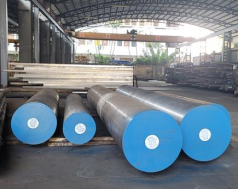 | 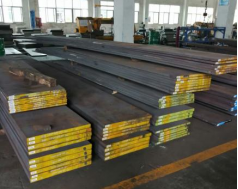 |
Equivalent Material & Chemical Composition
Standard | Grade | C | Si | Mn | P≤ | S≤ | Cr | Mo | V |
GB | Cr12Mo1V1 | 1.40-1.60 | ≤0.60 | ≤0.60 | 0.03 | 0.03 | 11.0-13.0 | 0.70-1.20 | 0.50-1.10 |
GOST | Х12МФ | 1.45-1.65 | 0.10-0.40 | 0.15-0.45 | 0.03 | 0.03 | 11.0-12.5 | 0.40-0.60 | 0.15-0.30 |
AISI | D2 | 1.40-1.60 | 0.10-0.60 | 0.10-0.60 | 0.03 | 0.03 | 11.0-13.0 | 0.70-1.20 | 0.50-1.10 |
DIN EN ISO 4957 | 1.2379/X153CrMoV12 | 1.45-1.60 | 0.10-0.60 | 0.20-0.60 | 0.03 | 0.03 | 11.0-13.0 | 0.70-1.00 | 0.70-1.00 |
JIS | SKD11 | 1.40-1.60 | ≤0.40 | ≤0.60 | 0.03 | 0.03 | 11.0-13.0 | 0.80-1.20 | 0.20-0.50 |
Characteristics
« High carbon, high-chromium (12%) steel for high performace cutting tools.Toughness better than D3.
« Nitridable.
« Particularly suitable for air hardening.
« Dimensionally stable.
« A high carbon and high chromium cold working tool steel.
« The steel is smelt by EAF+LF+VD or EAF+LF+VD+ESR.
« UT as per SEP 1921-84 D/d level, ESR material E/e level.
« Nitridable, high-alloy steel for through-hardening with moderate machinability.Good tensile strength and wear resistance.
« Good machinability and hardenability.
« Better toughness than Cr12MoV.
« Better size stability.
Applications
High-duty cutting tools (dies and punches), blanking and punching tools, woodworking tools, shear blades for cutting light-gauge material, thread rolling tools, tools for drawing, deep drawing and cold extrusion, pressing tools for the ceramics and pharmaceutical industries, cold rools (working rolls) for multiple-roll stands, measuring instruments and gauges, small moulds for the plastics industry where excellent wear resistance is required.
Physical Properties
Properties | Metric |
Density | 7.67×10³g/cm³ |
Coefficient of Thermal Expansion | 10.8μm/m℃ |
Thermal Conductivity | 20.5W/(m・K) |
Mechanical Properties
Properties | Metric |
Tensile strength (σb) | 1320MPa |
Yield strength (σs) | 194GPa |
Hardness | HBW≤255 |
Heat Treatment
Annealing
Heat the steel to a temperature range of 800 °C - 840 °C and then slowly cool it in the furnace. The hardness after annealing is approximately around 225 HB. If the machining operation is heavy or the cross-section of the cutting tool is unbalanced, stress can be relieved by heating to 650 °C - 700 °C before hardening, and then slowly cooling it down.
Hardening
Slowly preheat to a temperature range of 750 °C - 800 °C and soak thoroughly. Then continue to heat to the final hardening temperature range of 950 °C - 980 °C, and then cool it in air or quench it in oil. D6 steel is also suitable for vacuum (high-speed gas) hardening.
Tempering
Temper evenly and thoroughly at the selected tempering temperature, and maintain the temperature for at least one hour for every 25 mm of the total thickness. Moreover, secondary tempering should be carried out, with cooling to room temperature in between. The approximate hardness under different tempering temperatures is as follows: the hardness is 63 HRC after tempering at 100 °C, 62 HRC after tempering at 200 °C, 60 HRC after tempering at 300 °C, 58 HRC after tempering at 400 °C, 56 HRC after tempering at 500 °C, and 48 HRC after tempering at 600 °C.
| D3 ▏1.2080/X210Cr12 ▏SKD1 ▏Cr12 ▏Х12 | |
Category | Cold work tool steel | |
Delivery condition | Hot rolled & Hot forged, annealed to max. 250HB(≈max. 845 N/mm²) | |
Supply form | Round bar, Flat bar, Square bar | |
AISI D3 steel is a high-carbon and high-chromium cold work tool steel, which usually contains carbon, silicon, manganese, chromium, vanadium, as well as small amounts of phosphorus, sulfur, nickel, and copper. D3 Cold work tool steel equivalent material includes European EN, ISO, German DIN EN ISO 1.2080/X210Cr12, Japanese JIS standard SKD1, Chinese GB Cr12, etc. |
| 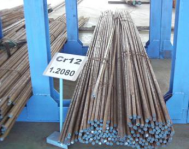 |
Equivalent Material & Chemical Composition
Standard | Grade | C | Si | Mn | P≤ | S≤ | Cr | V | W |
GB | Cr12 | 2.00~2.30 | ≤0.40 | ≤0.40 | 0.03 | 0.03 | 11.5-13.0 | ||
GOST | X12 | 2.00-2.20 | 0.10-0.40 | 0.15-0.45 | 0.03 | 0.03 | 11.5-13.0 | ||
AISI | D3 | 2.00-2.35 | 0.10-0.60 | 0.10-0.60 | 0.03 | 0.03 | 11.0-13.5 | ≤1.0 | ≤1.0 |
DIN | 1.2080/X210Cr12 | 1.90-2.20 | 0.10-0.60 | 0.20-0.60 | 0.03 | 0.03 | 11.0-13.0 | ||
JIS | SKD1 | 1.90-2.20 | 0.10-0.60 | 0.20-0.60 | 0.03 | 0.03 | 11.0-13.0 | <0.30 |
Characteristics
« The high chromium cold work steel.
« Has a very good resistance to abrasive wear.Very good compressive strength.
« The toughness property is moderate.
High-performance blanking dies, punching tools, punch, shear blades, knives Baking & head temple, broaches, drawing tools, drawing dies, ring rolling , wood cutter.
Properties | Metric |
Density | 7.7-8.03×10³kg/m³ |
Coefficient of Thermal Expansion | 10.7-12.3×10⁻⁶/m・K |
Thermal Conductivity | 42.7W/(m・K) |
Specific heat capacity | 477 J/(kg·K) |
Mechanical Properties
Properties | Metric |
Tensile strength (σb) | 1158MPa |
Yield strength (σs) | 1034MPa |
Hardness | HBW≤248 |
Heat Treatment
Annealing
Conventional Annealing:
Heat the steel to 850 °C - 900 °C and hold it for 2 - 4 hours to ensure uniform heating. Then slowly cool it in the furnace to below 200 °C and finally air cool it. After annealing, the hardness generally does not exceed around 250 HB, which can improve the cutting performance.
Isothermal Annealing:
Heat it to 800 °C and hold for 0.5 - 1 hour, then furnace cool it to 670 °C and hold for at least 10 hours. Next, cool it at a rate of 10 °C/h to 630 °C, and finally cool it in air. The maximum hardness is ≤ 240 HB.
Quenching
Oil Quenching:
First, preheat it to 700 °C - 750 °C, and then heat it to 960 °C - 1000 °C. The soaking time is determined according to the thickness of the workpiece, usually 15 - 30 minutes per millimeter. Subsequently, quickly cool it in oil. After quenching, the hardness can reach above 60 HRC.
Air Quenching:
For workpieces with a thickness not exceeding 30 mm, air quenching can be carried out at 950 °C - 980 °C, and the quenching hardness is ≥ 64.5 HRC.
Tempering
Generally, tempering is required after quenching. The tempering temperature is usually between 150 °C - 300 °C, such as 180 °C - 250 °C. Hold it for 2 - 4 hours to ensure that the internal stress in the material is completely released, and finally air cool it to room temperature. Tempering can eliminate the quenching stress, adjust the hardness, increase the toughness, and prevent the workpiece from brittle fracture. For some molds or tools with high requirements, multiple tempering may be required to further reduce the residual stress and achieve the optimal balance between hardness and toughness.
| D6 ▏1.2436/Х210CrW12 ▏Cr12W | |
Category | Cold work tool steel | |
Delivery condition | Hot rolled & Hot forged, annealed to max. 255HB | |
Supply form | Round bar, Flat bar | |
AISI D6 steel is a high-carbon and high-chromium tungsten cold work tool steel. Its main components include carbon, silicon, manganese, chromium, tungsten, and both the phosphorus and sulfur contents do not exceed 0.03%. D6 Cold work tool steel equivalent material includes European EN, ISO, German DIN EN ISO 1.2436/Х210CrW12, Chinese GB Cr12W, etc. |
|
Equivalent Material & Chemical Composition
Standard | Grade | C | Si | Mn | P≤ | S≤ | Cr | V | W |
GB | Cr12W | 2.00-2.30 | 0.10-0.40 | 0.30-0.60 | 0.03 | 0.03 | 11.0-13.0 | 0.60-0.80 | |
AISI | D6 | 2.00-2.35 | 0.10-0.60 | 0.10-0.60 | 0.03 | 0.03 | 11.00-13.5 | <1.0 | <1.0 |
DIN EN ISO 4957 | 1.2436/Х210CrW12 | 2.00-2.30 | 0.10-0.40 | 0.30-0.60 | 0.03 | 0.03 | 11.0-13.0 | 0.60-0.80 | |
DIN 17350 | 1.2436/Х210CrW12 | 2.00-2.25 | 0.10-0.40 | 0.15-0.45 | 0.03 | 0.03 | 11.0-12.0 | 0.60-0.80 |
Characteristics
« Ledeburitic 12% chromium steel.
« With improved hardenability and wear resistance.
Cutting tools, shearing knives, broaches, woodworking tools, profile and flanging rollers, thread rolling tools, deep drawing and pressing tools, drawing mandrels, guide rails, extrusion dies, sand blast nozzles, rotary shear knives.
Physical Properties
Properties | Metric |
Density | 7.67×10³g/cm³ |
Coefficient of Thermal Expansion | 10.8μm/m℃ |
Thermal Conductivity | 20.5W/(m・K) |
Mechanical Properties
Properties | Metric |
Tensile strength (σb) | 1320MPa |
Yield strength (σs) | 194GPa |
Hardness | HBW≤255 |
Heat Treatment
Annealing
Heat the steel to a temperature range of 800 °C - 840 °C and then slowly cool it in the furnace. The hardness after annealing is approximately around 225 HB. If the machining operation is heavy or the cross-section of the cutting tool is unbalanced, stress can be relieved by heating to 650 °C - 700 °C before hardening, and then slowly cooling it down.
Hardening
Slowly preheat to a temperature range of 750 °C - 800 °C and soak thoroughly. Then continue to heat to the final hardening temperature range of 950 °C - 980 °C, and then cool it in air or quench it in oil. D6 steel is also suitable for vacuum (high-speed gas) hardening.
Tempering
Temper evenly and thoroughly at the selected tempering temperature, and maintain the temperature for at least one hour for every 25 mm of the total thickness. Moreover, secondary tempering should be carried out, with cooling to room temperature in between. The approximate hardness under different tempering temperatures is as follows: the hardness is 63 HRC after tempering at 100 °C, 62 HRC after tempering at 200 °C, 60 HRC after tempering at 300 °C, 58 HRC after tempering at 400 °C, 56 HRC after tempering at 500 °C, and 48 HRC after tempering at 600 °C.
| L2 ▏1.2210/115CrV3 ▏SKS43 ▏5CrMnMo ▏11ChF | |
Category | Cold work tool steel | |
Delivery condition | Hot rolled & Hot forged, Soft annealed to max. 220HB | |
Supply form | Round bar, Flat bar | |
L2 is a high-performance cold work tool steel that occupies an important position in modern manufacturing due to its excellent mechanical properties and wide applicability. L2 Cold work tool steel equivalent material includes European EN, ISO, German DIN EN ISO 1.2210/115CrV 3, Japanese JIS standard SKS43, Chinese GB 5CrMnMo, etc | 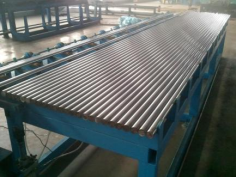 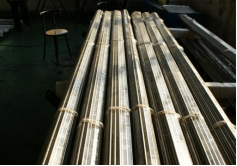 |
Equivalent Material & Chemical Composition
Standard | Grade | C | Si | Mn | P≤ | S≤ | Cr | Mo | Ni | V | W |
GB | 5CrMnMo | 0.50-0.60 | 0.25-0.60 | 1.20-1.60 | 0.03 | 0.03 | 0.60-0.90 | 0.15-0.30 | ≤0.25 | ||
GOST | 11ChF | 1.05-1.15 | 0.10-0.40 | 0.40-0.70 | 0.03 | 0.03 | 0.40-0.70 | <0.4 | 0.15-0.30 | <0.20 | |
AISI | L2 | 0.45-1.00 | 0.10-0.50 | 0.10-0.90 | 0.03 | 0.03 | 0.70-1.20 | ≤0.25 | 0.10-0.30 | ||
DIN | 1.2210/115CrV3 | 1.10-1.25 | 0.15-0.30 | 0.20-0.40 | 0.03 | 0.03 | 0.50-0.80 | 0.07-0.12 | |||
JIS | SKS43 | 1.00-1.10 | 0.10-0.30 | 0.10-0.40 | 0.03 | 0.03 | ≤0.20 | 0.10-0.20 |
Characteristics
« Cold work steel that can be used for a wide range of applications. Good machinability, high hardenability and wear resistance.
« Generally used for round dies.
Compared with AISI 1020, it has low alloy,but can be flamed or induction hardening to obtain high strength,and is widely used in many industries which require more strength,wear resistance,
Typical applications includes Axles,Bolts, Connecting Rods, Hydraulic Clamps ,Rams, Pins , Rolls, Studs, Shafts, Spindles, Sockets, Light gears etc.
Properties | Metric |
Density | 7.7-8.0 g/cm³ |
Coefficient of Thermal Expansion | 10-13×10⁻⁶/m・K |
Thermal Conductivity | 33 W/(m・K) |
Specific heat capacity | 450-500 J/(kg·K) |
Mechanical Properties
Properties | Metric |
Tensile strength (σb) | ≥2000 MPa |
Yield strength (σs) | ≥1800 MPa |
Hardness | 197-241 HB |
Elongation | 10% - 11% |
Heat Treatment
Annealing
Conventional Annealing: Heat the steel to a temperature range of 780 °C - 800 °C and hold it for 2 - 4 hours. Then slowly cool it in the furnace to below 500 °C before taking it out and air cooling it. After annealing, the hardness is generally around 200 HB, which can improve the cutting performance and eliminate internal stress.
Spheroidizing Annealing: Heat the steel to a temperature range of 760 °C - 780 °C and hold it for 2 - 4 hours. Then furnace cool it to a temperature range of 680 °C - 700 °C and hold it for another 4 - 6 hours. Finally, furnace cool it to below 500 °C before taking it out and air cooling it. After spheroidizing annealing, the microstructure is spheroidal pearlite, and the hardness is approximately 180 HB - 200 HB, which can further improve the cutting performance and prepare the microstructure for subsequent quenching.
Quenching
Heating Temperature: Usually, it is selected within the range of 800 °C - 850 °C. For example, for some small workpieces with simple shapes, a quenching temperature of around 820 °C can be adopted. For workpieces with complex shapes and larger sizes, the quenching temperature can be appropriately reduced to around 800 °C to reduce the risk of quenching deformation and cracking.
Cooling Methods: Oil cooling, water-oil dual-liquid cooling or alkali bath cooling can be used. Oil cooling has a relatively slow cooling speed during quenching, which can reduce quenching stress and deformation, but the quenching hardness may be slightly lower. Water-oil dual-liquid cooling involves cooling in water for a short period first and then quickly transferring to oil for cooling. This method can ensure a certain quenching hardness and control deformation to some extent. Alkali bath cooling has a moderate cooling speed and is suitable for workpieces with strict deformation requirements. After quenching, the hardness can reach around 60 HRC.
Tempering
Tempering Temperature: Generally, it is selected within the range of 150 °C - 300 °C, such as 180 °C - 250 °C. The specific temperature can be adjusted according to the required hardness and toughness. The number of tempering times is usually 2 - 3 times. After each tempering, it is necessary to cool to room temperature before conducting the next tempering.
Purpose of Tempering: The main purposes are to eliminate quenching stress, improve toughness and stabilize the microstructure and dimensions. When tempering within the range of 150 °C - 200 °C, the hardness drops slightly, and the main effect is to eliminate internal stress. When tempering within the range of 200 °C - 300 °C, the hardness will decrease to a certain extent, but the toughness will be significantly improved.
| S7 ▏1.2357/50CrMoV13-14 ▏5Cr3Mn1SiMo1V | |
Category | Cold work tool steel | |
Delivery condition | Hot rolled & Hot forged, annealed to max. 248HB | |
Supply form | Round bar, Flat bar | |
AISI S7 tool steel is a Shock-Resisting Steel with the highest hardenability and elevated temperature softening resistance of the S-series steels. Due to these properties, S7 material is popular in shock-resistant applications. They are moderately resistant to decarburization and grain growth. |
Equivalent Material & Chemical Composition
Standard | Grade | C | Si | Mn | P≤ | S≤ | Cr | Mo | V |
GB | 5Cr3Mn1SiMo1V | 0.45-0.55 | 0.20-1.00 | 0.20-0.90 | 0.03 | 0.03 | 3.0-3.5 | 1.30-1.80 | ≤0.35 |
AISI | S7 | 0.45-0.55 | 0.20-1.00 | 0.20-0.90 | 0.03 | 0.03 | 3.00-3.50 | 1.30-1.80 | ≤0.35 |
DIN | 1.2357/50CrMoV13-14 | 0.45-0.55 | 0.20-0.80 | 0.50-0.90 | 0.03 | 0.03 | 3.0-3.50 | 1.30-1.70 | 0.15-0.35 |
Characteristics
« S7 is a general purpose air hardening tool steel having high impact and shock resistance.
« It has good resistance to softening at moderately high temperatures.
« This combination of properties makes it suitable for many hot-work and cold-workapplications.
Machine knife (for producers); Rolling Cold; Forming; Fine Blanking, Stamping, Blanking; Powder Pressing.
Physical Properties
Properties | Metric |
Density | 7.76×10³kg/m³ |
Coefficient of Thermal Expansion | 12.6-13.7 μm/m・K |
Elastic modulus | 207 GPa |
Poisson's ratio | 0.27-0.30 |
Mechanical Properties
Properties | Metric |
Tensile strength (σb) | 1240-2170 MPa |
Yield strength (σs) | 1035-1585 MPa |
Hardness | 248HB |
Elongation | 7%-14% |
Reduction of Area | 20%-45% |
Heat Treatment
Annealing
Heat to 845 °C and hold for 2 hours. Then slowly cool to 540 °C at a rate of 30 °C per hour, and then air cool. Alternatively, heat to 845 °C and hold for 2 hours. After cooling to 760 °C, hold for another 4 hours, and then air cool.
Quenching
1.Preheating: In the first stage, preheat to 677 ± 1 °C. In the second stage, preheat by heating in a salt bath at 941 °C or in a furnace-controlled atmosphere at 955 ± °C, hold for approximately 1 minute, and then air cool.
2.Austenitizing Temperature: It is usually around 940 °C - 955 °C.
3.Soaking Time: It depends on the size of the workpiece and the loading quantity in the furnace. Generally, it ranges from 14 to 45 minutes.
4.Quenching Medium: For cross-sectional dimensions of 2.5 inches and below, air quenching can be adopted. For cross-sections ranging from 2.5 inches to 6 inches, oil quench to 1000 °F first and then air cool to 150 °F. For larger cross-sections, oil quench to 150 °F.
Tempering
The tempering temperature is usually selected within the range of 5 - 204 °C. The tempering temperature is determined according to the specific usage requirements of the dies or tools. For cold working and similar applications, a temperature range of 400 °F - 500 °F is recommended, while for hot working applications, a temperature range of 900 °F - 1000 °F is adopted. During tempering, temper for about one hour for each inch of cross-sectional thickness. Generally, one tempering is sufficient, but for some cases with higher requirements, multiple tempering may be needed.